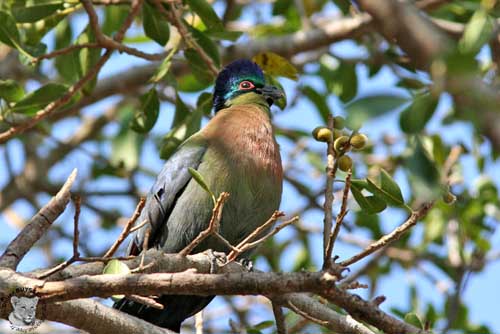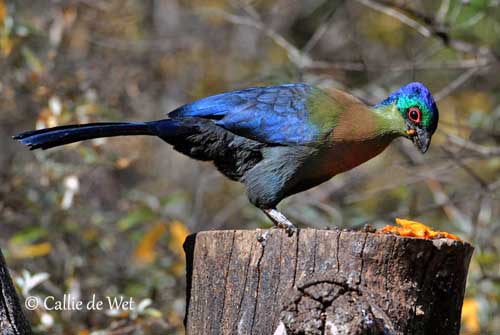
Fr: Touraco à huppe splendide
All : Glanzhaubenturako
Esp: Turaco Crestimorado
Ital : Turaco crestaviola
Nd: Purperkuiftoerako
Sd: Stålgrå turako
Afrikaans: Bloukuifloerie
Photographers:
Didier Buysse
Vision d’Oiseaux
Ingo Waschkies
Bird Photography
Callie de Wet
GALLERY
Text by Nicole Bouglouan
Sources:
HANDBOOK OF THE BIRDS OF THE WORLD vol 4 by Josep del Hoyo-Andrew Elliott-Jordi Sargatal - Lynx Edicions - ISBN: 8487334229
BIRDS OF AFRICA SOUTH OF THE SAHARA by Ian Sinclair and Peter Ryan - Princeton University Press Princeton and Oxford - ISBN: 0691118159
ROBERTS BIRDS OF SOUTH AFRICA by G. R. Mc Lachlan and R. Liversidge – The Trustees of the John Voelcker Bird Book Fund – ISBN: 0620031182
BirdLife International (BirdLife International)
Roberts online. Birds of Southern Africa
Purple-crested Turaco
Tauraco porphyreolophus
Musophagiforme Order – Musophagidae Family
BIOMETRICS:
Length: 42-46 cm
Weight: M: 225-300 g – F: 218-325 g
DESCRIPTION:
The Purple-crested Turaco is a fruit-eater. Its glossy and colourful plumage makes this bird very attractive for humans. Turacos have been hunted in the past for their beautiful red flight feathers used as adornments by African people. Today, this species has adapted to suburban life, especially in Durban.
The adult has green washed rose-pink upper back and breast. Lower back and wing-coverts are greyish-blue, except the lesser wing-coverts. The rump is dull blue-black.
Uppertail-coverts, tail and inner secondaries are glossy violet-blue washed green. Primary and outer secondary flight feathers are crimson with dark brown edges and tips.
On the underparts, the breast is green washed pink. Belly and thighs are pale bluish-grey.

On the head, forehead, superciliary area, cheeks and ear-coverts are glossy green. Crown, rounded crest and nape are iridescent dark violet-purple. Lower cheeks, chin, throat and neck are olive-green.
The bill is black. The eyes are dark brown, surrounded by scarlet bare eyering. Legs and feet are blackish-blue.
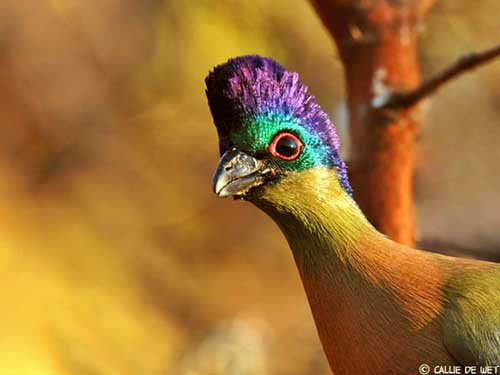
Both adults are similar. The juvenile is duller.
There are two subspecies:
T.p. porphyreolophus (here described and displayed), is found in Zimbabwe and Mozambique, S to Transvaal and Natal.
T.p. chlorochlamys is found is SE Kenya through Tanzania, Burundi and Rwanda to Zambia, Malawi and N Mozambique.
This race lacks the pink tinge on upper back and breast. The bare red eyering extends farther forwards. On the underparts, belly and thighs are dull greenish-grey. Tail and secondaries lack the greenish tones.
VOICE: SOUNDS BY XENO-CANTO
The Purple-crested Turaco gives loud series of hollow “krook-krook-krook-krook”, longer and faster than in other green turacos. This series precedes several shrill wailing notes “prru…prru”.
Sounds are typically heard at dawn and dusk. Both mates sing and often in duets.
HABITAT:
The Purple-crested Turaco frequents moist woodlands, evergreen thickets and riparian growths. According to the range, it also frequents coastal forest and even suburban areas, parks and gardens, including exotic plantations.
This species is visible from sea-level up to 1800-1900 metres of elevation.
RANGE:
See above in “subspecies”
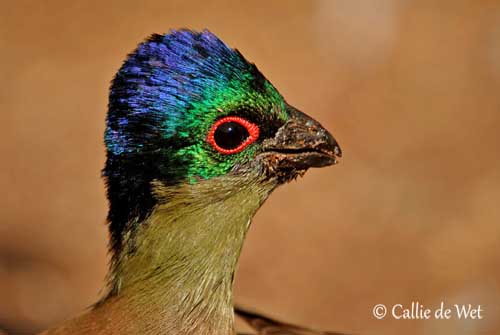
BEHAVIOUR:
The Purple-crested Turaco is frugivorous and feeds on fruits from numerous plant species. It forages in canopy, picking the fruits by perching at the end of the branches. This bird does not feed on the ground, except in captivity.
The small fruits are swallowed whole, whereas the larger items are cut into pieces with the bill. It takes both wild and cultivated fruits, and some buds.
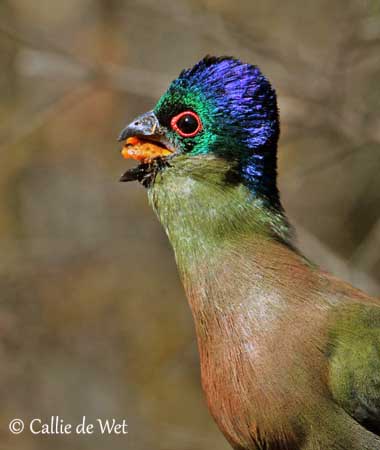
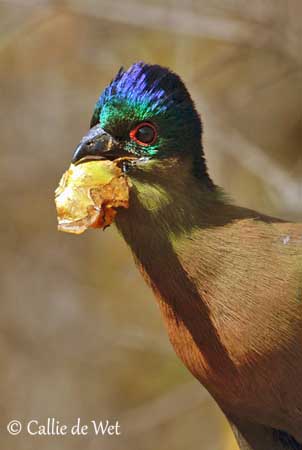
They are often seen singly or in pairs, and occasionally in small groups of 4-5 birds. They sometimes descend to the ground for drinking and bathing, but they are mainly arboreal.
During the breeding season, they are strongly territorial. Most of them live in pairs all year round and remain in their territory. This area is defended against intruders. They breed solitary in their territory.
The beginning of the rainy season stimulates the courtship activities, including calling and chasing from tree to tree, mutual feeding and several displays. The birds open and close the bill, the crest is raised and lowered and the head pattern is enhanced by some postures. They bow and move the tail. But the main display is the spreading of the wings in order to expose the crimson patches.
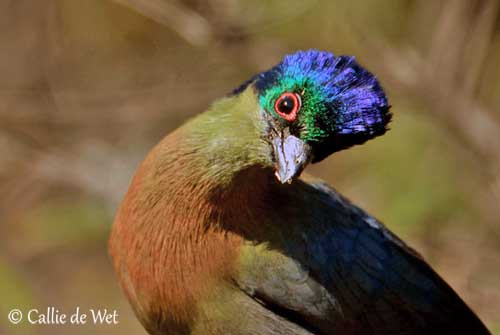
The Purple-crested Turaco moves with agility among the branches, running easily along them and bounding between them.
Some fights may occur during this period. The birds adopt an upright stance with outstretched legs, erect crest and the tail flicking strongly. The head is lowered and stretched forwards. The aim is to displace the rival from its perch.
These displays are also used when several birds are feeding together in the same fruiting tree. Sometimes, two birds may react strongly to each other and chases are reported.
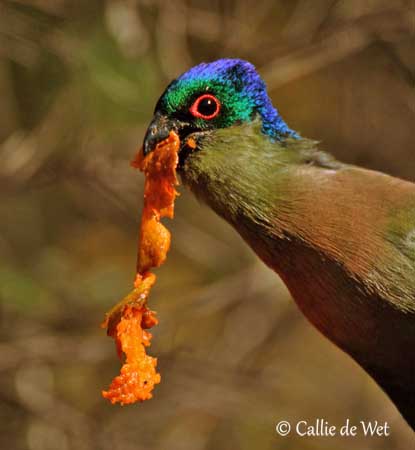
The Purple-crested Turaco performs limited movements, often closely related to rains and food resources at fruiting trees.
FLIGHT:
The Purple-crested Turaco, as other turacos, is a poor flier. But it moves with great agility from tree to tree in the canopy, alternating flapping and gliding. It takes flight with a short downwards glides and some fast wingbeats to the next tree. Then, it climbs and clambers back to the canopy with short hops, leaps and bounds.
REPRODUCTION:
The breeding season varies according to the range.
The nest of the Purple-crested Turaco is often placed high in tree or shrub, about 20 metres above the ground. It is a flat structure made with sticks and twigs and usually flimsy, often similar to the nests of Columbidae. This platform is well concealed among the thick vegetation.
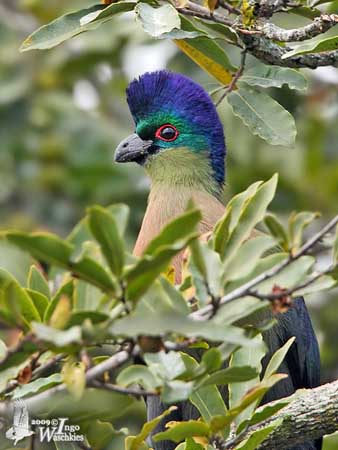
The female lays 2-3 glossy white eggs. Both adults incubate during 22-23 days. At hatching, the chicks are covered in thick greyish-brown down. During the first days, they are brooded almost continuously. They are fed by regurgitation by their parents. The adults clean regularly the nest.
At about three weeks of age, the young move out of the nest and climb about in the nesting-tree. They are able to fly at 38 days old.
DIET:
The Purple-crested Turaco feeds almost exclusively on wild and cultivated fruits, and takes sometimes buds. It forages in the canopy.
PROTECTION / THREATS / STATUS:
The Purple-crested Turaco is common in several parts of the range in spite of heavy habitat loss and trapping in Tanzania.
The subspecies “chlorochlamys” is evaluated as Near Threatened within its range, with only some small isolated groups.
However, the nominate race is not currently threatened.
